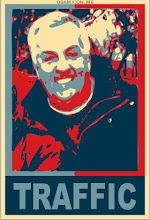The link between private grief and public safety
 Memorial to Robert Winkler outside Herrin, Illinois Photo: Stephen Chalmer , c/o HumanFlowerProject.com
Memorial to Robert Winkler outside Herrin, Illinois Photo: Stephen Chalmer , c/o HumanFlowerProject.comThe piles of notes and flowers left at the scenes of fatal car crashes can actually make drivers more cautious, a researcher finds
by IAN BAILEY, The Globe and Mail, November 8, 2008
by IAN BAILEY, The Globe and Mail, November 8, 2008
Richard Tay set up fake memorials at four intersections with red-light cameras in Calgary, then monitored how the memorials affected traffic. Prof. Tay, who holds the Alberta Motor Association Chair in Road Safety at the Schulich School of Engineering, found that about 17 per cent fewer drivers ran red lights at the target intersections over the six weeks of the test than in the previous six weeks.
"In terms of safety, these things have a positive benefit," he said in an interview yesterday. "They give us a safety message to drive more cautiously." More than 60 per cent of 810 respondents to an online survey supported municipal policies that allow the memorials, although about half said time limits should be imposed on how long they could remain in place.
"The important thing is we haven't found any negative side effects, but we did find some positive benefits in the short term, so I suggest municipalities allow them, but impose some sort of control on them."
"The important thing is we haven't found any negative side effects, but we did find some positive benefits in the short term, so I suggest municipalities allow them, but impose some sort of control on them."
Policies vary among provinces and in municipalities across Canada; some have specific rules, but others don't take any steps to regulate them. Calgary's traffic department, which helped Prof. Tay with his research, is developing a formal proposal for city council to consider next February. It would cover points such as where memorials are allowed. Troy McLeod, Calgary's traffic-safety manager, said his department is sensitive to memorials. It usually removes them from dangerous, inaccessible high-traffic areas such as highways because of fears for the safety of families maintaining them, but the department contacts families before taking them down.
"There may not be one way to do them, but we're trying to be respectful and sensitive. If you put yourself in anyone's shoes, it's a difficult time." He said that it seems the number of memorials has been growing in the 15 years he has been in the job, but added he has no statistics to back up that perception.
An official with the Federation of Canadian Municipalities, speaking on condition of anonymity, said the issue of roadside-memorial policy has never come up as something the organization would seriously research or take a position on. Prof. Tay, who said he wanted to come up with data to help municipalities form policies on memorials, said communities should let them proceed, but not let them get out of control.
He went to unusual lengths for his research, which had its genesis at a 2006 meeting of traffic experts in Ottawa when questions were raised about municipal policies on roadside memorials and participants realized that policies were inconsistent.
There wasn't much research on the memorials' impact on traffic, he said, only studies that focused on sociology and grieving. In designing the study, it was necessary to build fake memorials. Researchers studied memorials around Calgary and elsewhere in Alberta, trying to understand the basic elements. "We designed our memorial to look like what we normally see on the road. Real memorials normally have a name. For our research, we put, 'This is a research experiment by the University of Calgary,' and the contact information for them to find out more information," he said.
Holly Everett, an assistant folklore professor at Memorial University in St. John's, has written on the subject of memorials, and said yesterday that she had heard about Prof. Tay's study.
"It's interesting because [the study] parallels what many people have told me about roadside memorials during my own research. A number of people that I interviewed told me that they automatically slow down or are more cautious whenever they see a roadside memorial, whether or not they have any connection to the memorial or knowledge about what caused the accident," Prof. Everett said in an e-mailed response to questions from The Globe and Mail.
"Similarly, every individual I interviewed who was directly involved in creating or maintaining a memorial told me that, if the memorial was responsible for even one person being more cautious when driving through that particular area, then it was worth all the effort and care that went into it."
***
ORIGINS
In North America, the memorials originated in the U.S. Southwest with roots in Hispanic culture, Catholicism and funerary rites dating back more than 200 years. "The purpose of these small, white crosses at the roadside was to mark the rest areas for funeral procession pallbearers travelling by foot from the church to the graveyard. These sanctified, holy rest areas which are called Descansos (Spanish for "resting place") have since evolved into markers of the location of traffic fatalities by the side of the road," Richard Tay's study says. "The vast majority of memorials consist of a cross, often white, with flowers, photos, notes, cards, dolls or various other memorabilia."
The authors of one study quoted by Prof. Tay did a survey of bereaved families, who said most memorials were placed for teenagers, whose deaths were considered "unexpected, traumatic and unprecedented." Most of the people who put up the memorials wanted them in place as a focus for their grief with the idea of warning other motorists of the risks in the area of an accident as "an after-thought, or in some cases, a secondary rationale for justifying the placement of the memorial."
-- Ian Bailey

